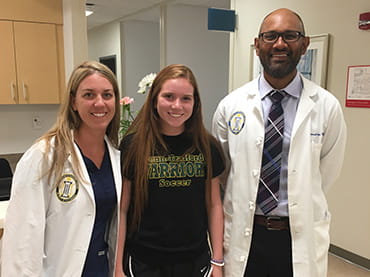The Challenge: Soccer Injury
During the last ten seconds of a soccer game her sophomore year, Erin slipped and fell.
“I planted my foot and slipped. I was cutting with the ball when my knee went one way and my body the other,” says Erin. “I just knew something terrible had happened.”
Erin thought she tore her MCL because she did not hear a popping sound that is often linked to an ACL tear.
Erin scheduled appointments with a physical therapist as well as with orthopaedic surgeon Dharmesh Vyas, MD PhD, to determine the extent of her injury.
“My first game back was a little nerve-racking because I tore my ACL cutting during a game, but I knew I was stronger than I was before.” — Erin Brady
The Path to UPMC: ACL and MCL Surgery
After undergoing a clinical exam in Dr. Vyas’ office and subsequent MRI, this confirmed her fears.
In addition to her MCL and meniscus, Erin also had torn her ACL. Despite the setback of her knee injury, Dr. Vyas was confident that Erin would be back on the soccer field to play during her junior year.
“Dr. Vyas was fabulous from day one,” says Erin’s mother, Dawn. “He was calm and reassured us that Erin would be okay.”
Two weeks prior to ACL and MCL reconstruction surgery, Erin went through pre-rehabilitation to build up strength in her right knee.
The Results: Rehabilitation and Returning to Play
Rehabilitation after ACL reconstruction surgery cannot be rushed.
As eager as Erin was to get back to playing soccer, she listened and followed the individualized recovery program. Dr. Vyas and physical therapist Ashley Johnson PT, DPT, CKTP, created her recovery program.
To get Erin back on to the field, there were three numbers that Dr. Vyas used to describe her recovery timeline: three, six, and nine.
At three months, Erin would be allowed to jog again. At six months, she would be fitted for a knee brace to wear while incorporating soccer related exercises into her rehabilitation program. At nine months, if she followed her recovery program, Dr. Vyas would clear her to return to play.
In the beginning of her physical therapy, Ashley incorporated exercises that helped strengthen Erin’s legs and core to benefit her knee and balance.
She used free weight machines to perform leg presses, leg extensions, and hamstring curls. Ashley also had Erin perform leg lifts on a balance trainer.
Erin’s knee went through Blood Flow Restriction (BFR) therapy, limiting blood flow to the muscles. This allowed her to increase her quadriceps strength by recruiting her body’s own growth factors to help accelerate the process.
Six months post-surgery, Erin, now fitted with a knee brace, was performing soccer related exercises that incorporated, box jumps, lunges, and cutting drills to help reintroduce her body to the movements of her sport.
“When I first started wearing the brace, I would run a mile at the local track, just so I could get used to wearing it,” remembers Erin. “Dr. Vyas recommended that I wear the brace for a full year after my surgery even while playing in games.”
At nine months, and less than 10 days before the start of high school soccer practices, Dr. Vyas cleared Erin to return to practice. Her coach helped ease Erin back into soccer by having her participate as “non- contact”.
“My first game back was a little nerve-racking because I tore my ACL cutting during a game, but I knew I was stronger than I was before.”
Erin’s junior season of soccer was a memorable one with her high school team clinching the WPIAL title.
“We can’t say enough to everyone who was involved with helping Erin return to soccer,” says Dawn, “It was a great experience for a very unfortunate event.”

















